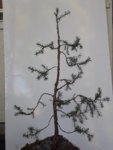If it hardly shows the 'bite in' in a couple months I'll keep it on longer.
There is no way to know in advance how long you can keep wire on. Biting in is not the horrible thing that most newbies think it is! It’s how branches get set. And most wiring scars heal pretty quickly once the wire is removed.
1mm wire is pretty thin. And here’s the thing, it tends to “cut in” faster than thicker wire!
Remember, the wire doesn’t “cut in”. Theveire foesnt move. The branch thickens as it grows. And if it touches wire, it bulges up on either side of the wire. The best way to remove wire when this has happened is to unwind it. NOT cut it out. Unwinding will lift it straight out of the groove. Trying to cut it will require you to cut the bulges on the sides.
Thicker wire makes a wider contact area so the scars are broader. And less apparent.
So, since you only have two sizes of wire, if often better to choose a thicker wire than a thinner one.
By the way, 1mm is really too thin to do anything but the smallest of twigs. Branches, it’s too weak. Oh, I know you think you’ve wired the branches! But I bet if you give them a light tap, they will vibrate back and forth! When we wire, and positioned the branches, we don’t want them to move. They should stay put!
Your wiring is much, much better! Still room for improvement, but it’s a LOT better than before!
The shape of a lot of your branches needs improvement. Several are bent in “rainbow” curves. It would look better if the branch was bent down right where it attaches to the trunk. This requires good wiring right at the trunk-branch junction, and stronger wire!
You’ll develop a touch for it as you practice!
Colin’s video talks about wiring. How to put on the wire. He doesn’t spend a lot of time talking about how to bend branches if I recall. Putting the wire on is step one. Step two is bending and styling. And is much harder to teach!
For now, see if you can find some more wire. As you’ve discovered,you really do need a full set of thicknesses.


